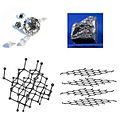Allotropy facts for kids

Allotropy is a cool science idea where a single chemical element can show up in different forms, even when it's in the same physical state (like all solid, all liquid, or all gas). Think of it like having different outfits for the same person! These different forms are called allotropes.
So, an allotrope is just a different way an element's atoms are connected or arranged. This happens because the atoms are bonded together in unique patterns.
Only some elements have allotropes. For example, carbon is famous for its many allotropes.
Contents
What is Allotropy?
Allotropy describes how an element can exist in more than one structural form. Each form has different physical and chemical properties, even though they are made of the exact same type of atom.
Allotropes vs. Polymorphism
The word allotropy is used only for elements. When we talk about different forms of a chemical compound (which is made of two or more elements), we use a more general term called polymorphism.
It's important to remember that allotropy refers to different forms of an element within the same state. For example, solid carbon can be diamond or graphite. But if carbon turns into a liquid or gas, those different states themselves are not called allotropes.
Carbon's Amazing Forms
Carbon is a fantastic example of an element with many allotropes. Its atoms can link up in several different ways, creating materials with very different looks and uses.
Diamond: The Hardest Allotrope
- Diamond is one of carbon's most famous allotropes.
- In diamond, each carbon atom is strongly bonded to four other carbon atoms.
- These bonds form a super strong, four-cornered structure.
- This special arrangement makes diamond incredibly hard and shiny. It's often used in jewelry and for cutting tools.
Graphite: Soft and Slippery
- Graphite is another common allotrope of carbon.
- Unlike diamond, carbon atoms in graphite are arranged in flat sheets.
- Each sheet is made of six-sided rings, like a honeycomb.
- These sheets can slide past each other easily, which is why graphite feels slippery. It's used in pencils and as a lubricant.
Graphene: Super Thin Sheets
- Graphene is basically a single, super-thin sheet of graphite.
- It's only one atom thick, making it incredibly light and strong.
- Scientists are very excited about graphene because of its amazing properties. It could be used in future electronics and super-strong materials.
Fullerenes: Spheres and Tubes
- Fullerenes are another group of carbon allotropes.
- In fullerenes, carbon atoms bond together to form hollow shapes.
- These shapes can be spheres (like tiny soccer balls), cylinders (like tiny tubes), or even egg-shaped structures.
- The most famous fullerene is Buckminsterfullerene, which looks like a tiny soccer ball. Fullerenes have potential uses in medicine and nanotechnology.
Images for kids
See also
 In Spanish: Alotropía para niños
In Spanish: Alotropía para niños



